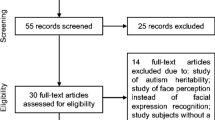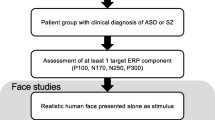Abstract
Studies on processing of emotional faces in individuals with autism spectrum disorder (ASD) have shown mixed findings. The goal of this systematic review was to investigate brain electrical responses to emotional facial expressions in individuals with ASD. We conducted a literature search of nine databases and grey literature sources up to Jan 2017, resulting in 943 studies. Eleven studies met inclusion criteria, with quality assessments varying from three to six out of 10. This systematic review demonstrates that individuals with ASD show a lack of sensitivity to different emotional expressions, especially fear, compared to their peers. Atypical brain responses in processing emotional faces may reflect the abnormalities in visual perception and information processing that are present early in life.

Similar content being viewed by others
References
Adams Jr., R. B., & Kleck, R. E. (2005). Effects of direct and averted gaze on the perception of facially communicated emotion. Emotion, 5(1), 3–11.
Akechi, H., Senju, A., Kikuchi, Y., Tojo, Y., Osanai, H., & Hasegawa, T. (2010). The effect of gaze direction on the processing of facial expressions in children with autism spectrum disorder: an ERP study. Neuropsychologia, 48(10), 2841–2851.
Allison, T., Puce, A., & McCarthy, G. (2000). Social perception from visual cues: role of the STS region. Trends in Cognitive Sciences, 4(7), 267–278.
American Psychiatric Association. (2013) The Diagnostic and Statistical Manual of Mental Disorders: DSM 5. bookpointUS.
Apicella, F., Sicca, F., Federico, R. R., Campatelli, G., & Muratori, F. (2013). Fusiform gyrus responses to neutral and emotional faces in children with autism spectrum disorders: a high density ERP study. Behavioural Brain Research, 251, 155–162.
Ashwin, C., Chapman, E., Colle, L., & Baron-Cohen, S. (2006). Impaired recognition of negative basic emotions in autism: a test of the amygdala theory. Social Neuroscience, 1(3–4), 349–363.
Baio, J. (2012). Prevalence of autism spectrum disorders: autism and developmental disabilities monitoring network, 14 sites, United States, 2008. Morbidity and mortality weekly report. Surveillance summaries. Centers for Disease Control and Prevention, 61(3).
Baron-Cohen, S. (2010). Empathizing, systemizing, and the extreme male brain theory of autism. Progress in Brain Research, 186, 167–175.
Baron-Cohen, S., Wheelwright, S., Hill, J., Raste, Y., & Plumb, I. (2001). The “reading the mind in the eyes” test revised version: a study with normal adults, and adults with Asperger syndrome or high-functioning autism. Journal of Child Psychology and Psychiatry, 42(2), 241–251.
Batty, M., & Taylor, M. J. (2003). Early processing of the six basic facial emotional expressions. Cognitive Brain Research, 17(3), 613–620.
Batty, M., & Taylor, M. J. (2006). The development of emotional face processing during childhood. Developmental Science, 9(2), 207–220.
Batty, M., Meaux, E., Wittemeyer, K., Rogé, B., & Taylor, M. J. (2011). Early processing of emotional faces in children with autism: an event-related potential study. Journal of Experimental Child Psychology, 109(4), 430–444.
Behrmann, M., Thomas, C., & Humphreys, K. (2006). Seeing it differently: visual processing in autism. Trends in Cognitive Sciences, 10(6), 258–264.
Bird, G., Press, C., & Richardson, D. C. (2011). The role of alexithymia in reduced eye-fixation in autism spectrum conditions. Journal of Autism and Developmental Disorders, 41(11), 1556–1564.
Boraston, Z., Blakemore, S.-J., Chilvers, R., & Skuse, D. (2007). Impaired sadness recognition is linked to social interaction deficit in autism. Neuropsychologia, 45(7), 1501–1510.
Bormann-Kischkel, C., Vilsmeier, M., & Baude, B. (1995). The development of emotional concepts in autism. Journal of Child Psychology and Psychiatry, 36(7), 1243–1259.
Cook, R., Brewer, R., Shah, P., & Bird, G. (2013). Alexithymia, not autism, predicts poor recognition of emotional facial expressions. Psychological Science, 24(5), 723–732.
Dawson, G., Carver, L., Meltzoff, A. N., Panagiotides, H., McPartland, J., & Webb, S. J. (2002). Neural correlates of face and object recognition in young children with autism spectrum disorder, developmental delay, and typical development. Child Development, 73(3), 700–717.
Dawson, G., Webb, S. J., Carver, L., Panagiotides, H., & McPartland, J. (2004). Young children with autism show atypical brain responses to fearful versus neutral facial expressions of emotion. Developmental Science, 7(3), 340–359.
Dawson, G., Webb, S. J., & McPartland, J. (2005). Understanding the nature of face processing impairment in autism: insights from behavioral and electrophysiological studies. Developmental Neuropsychology, 27(3), 403–424.
De Jong, M. C., Van England, H., & Kemner, C. (2008). Attentional effects of gaze shifts are influenced by emotion and spatial frequency, but not in autism. Journal of the American Academy of Child & Adolescent Psychiatry, 47(4), 443–454.
Dimitriou, D., Leonard, H. C., Karmiloff-Smith, A., Johnson, M. H., & Thomas, M. S. (2015). Atypical development of configural face recognition in children with autism, Down syndrome and Williams syndrome. Journal of Intellectual Disability Research, 59(5), 422–438.
Federico, R. R. (2011). A study on cerebral activity by means of combined EEG-fMRI in neuropsychological disorders in childhood.
Fujita, T., Kamio, Y., Yamasaki, T., Yasumoto, S., Hirose, S., & Tobimatsu, S. (2013). Altered automatic face processing in individuals with high-functioning autism spectrum disorders: evidence from visual evoked potentials. Research in Autism Spectrum Disorders, 7(6), 710–720.
Gross, E., El-Baz, A. S., Sokhadze, G. E., Sears, L., Casanova, M. F., & Sokhadze, E. M. (2012). Induced eeg gamma oscillation alignment improves differentiation between autism and ADHD group responses in a facial categorization task. Journal of Neurotherapy, 16(2), 78–91.
Happé, F., & Frith, U. (2006). The weak coherence account: Detail-focused cognitive style in autism spectrum disorders. Journal of Autism and Developmental Disorders, 36(1), 5–25.
Harms, M. B., Martin, A., & Wallace, G. L. (2010). Facial emotion recognition in autism spectrum disorders: a review of behavioral and neuroimaging studies. Neuropsychology Review, 20(3), 290–322.
Howard, M. A., Cowell, P. E., Boucher, J., Broks, P., Mayes, A., Farrant, A., & Roberts, N. (2000). Convergent neuroanatomical and behavioural evidence of an amygdala hypothesis of autism. Neuroreport, 11(13), 2931–2935.
Kim, S. Y., Choi, U. S., Park, S. Y., Oh, S. H., Yoon, H. W., Koh, Y. J., ... & Lee, C. U. (2015). Abnormal activation of the social brain network in children with autism spectrum disorder: an FMRI study. Psychiatry Investigation, 12(1), 37–45.
Loveland, K. A., Tunali-Kotoski, B., Chen, Y. R., Ortegon, J., Pearson, D. A., Brelsford, K. A., & Gibbs, M. C. (1997). Emotion recognition in autism: verbal and nonverbal information. Development and Psychopathology, 9(3), 579–593.
McPartland, J., Dawson, G., Webb, S. J., Panagiotides, H., & Carver, L. J. (2004). Event-related brain potentials reveal anomalies in temporal processing of faces in autism spectrum disorder. Journal of Child Psychology and Psychiatry, 45(7), 1235–1245.
Modesti, P., Reboldi, G., Cappuccio, F., Agyemang, C., Remuzzi, G., Rapi, S., . . . ESH Working Group on CV Risk in Low Resource Settings. (2016). Panethnic differences in blood pressure in europe: a systematic review and meta-analysis. PLoS One, 11(1), e0147601.
Moher, D., Liberati, A., Tetzlaff, J., Altman, D. G., & The PRISMA Group. (2009). Preferred Reporting Items for Systematic Reviews and Meta-Analyses: the PRISMA statement. PLoS Medicine, 6(7), e1000097.
Nakahachi, T., Yamashita, K., Iwase, M., Ishigami, W., Tanaka, C., Toyonaga, K., … & Takeda, M. (2008). Disturbed holistic processing in autism spectrum disorders verified by two cognitive tasks requiring perception of complex visual stimuli. Psychiatry Research, 159(3), 330–338.
O’Connor, K., Hamm, J. P., & Kirk, I. J. (2005). The neurophysiological correlates of face processing in adults and children with Asperger’s syndrome. Brain and Cognition, 59(1), 82–95.
Pelphrey, K. A., Sasson, N. J., Reznick, J. S., Paul, G., Goldman, B. D., & Piven, J. (2002). Visual scanning of faces in autism. Journal of Autism and Developmental Disorders, 32(4), 249–261.
Rossignol, M., Philippot, P., Douilliez, C., Crommelinck, M., & Campanella, S. (2005). The perception of fearful and happy facial expression is modulated by anxiety: an event-related potential study. Neuroscience Letters, 377(2), 115–120.
Rossignol, M., Anselme, C., Vermeulen, N., Philippot, P., & Campanella, S. (2007). Categorical perception of anger and disgust facial expression is affected by non-clinical social anxiety: an ERP study. Brain Research, 1132(1), 166–176.
Rump, K. M., Giovannelli, J. L., Minshew, N. J., & Strauss, M. S. (2009). The development of emotion recognition in individuals with autism. Child Development, 80(5), 1434–1447.
Sinzig, J., Morsch, D., & Lehmkuhl, G. (2008). Do hyperactivity, impulsivity and inattention have an impact on the ability of facial affect recognition in children with autism and ADHD? European Child & Adolescent Psychiatry, 17(2), 63–72.
Smith, M. L., Cottrell, G. W., Gosselin, F., & Schyns, P. G. (2005). Transmitting and decoding facial expressions. Psychological Science, 16(3), 184–189.
Speer, L. L., Cook, A. E., McMahon, W. M., & Clark, E. (2007). Face processing in children with autism effects of stimulus contents and type. Autism, 11(3), 265–277.
Uljarevic, M., & Hamilton, A. (2013). Recognition of emotions in autism: a formal meta-analysis. Journal of Autism and Developmental Disorders, 43(7), 1517–1526.
Vlamings, P. H. J. M., Jonkman, L. M., van Daalen, E., van der Gaag, R. J., & Kemner, C. (2010). Basic abnormalities in visual processing affect face processing at an early age in autism spectrum disorder. Biological Psychiatry, 68(12), 1107–1113.
Wagner, J. B., Hirsch, S. B., Vogel-Farley, V. K., Redcay, E., & Nelson, C. A. (2013). Eye-tracking, autonomic, and electrophysiological correlates of emotional face processing in adolescents with autism spectrum disorder. Journal of Autism and Developmental Disorders, 43(1), 188–199.
Wells, G., Shea, B., O’Connell, D., Peterson, J., Welch, V., Losos, M., & Tugwell, P. (2000). The Newcastle-Ottawa Scale (NOS) for assessing the quality of nonrandomised studies in meta-analyses. http://www.ohri.ca/programs/clinical_epidemiology/oxford.asp.
Wong, T. K., Fung, P. C., Chua, S. E., & McAlonan, G. M. (2008). Abnormal spatiotemporal processing of emotional facial expressions in childhood autism: Dipole source analysis of event-related potentials. European Journal of Neuroscience, 28(2), 407–416.
Acknowledgements
We would like to express our thanks to librarian Charlotte Beck who assisted in developing our search.
Funding
This study was not funded by any sources or agencies.
Author information
Authors and Affiliations
Corresponding author
Ethics declarations
Conflict of Interest
Dr. Zwicker is funded by the Michael Smith Foundation for Health Research, Canadian Child Health Clinician Scientist Program, BC Children’s Hospital, Sunny Hill Foundation, and Canadian Institutes of Health Research. Dr. Zwicker has also received speaker honoraria from McGill University, University of Montreal, University of Toronto, Cincinnati Children’s Hospital, and Children’s Hospital at Westmead.
Ethical Approval
This article does not contain any studies with human participants performed by any of the authors.
Additional information
At this time of this study, Parisa Ghanouni was a doctoral student in the Rehabilitation Sciences at the University of British Columbia, Vancouver, Canada. Dr. Zwicker is an Assistant Professor in the Department of Occupational Science and Occupational Therapy and an Associate Member in the Department of Pediatrics at the University of British Columbia, Vancouver, Canada. She also holds appointments as Investigator, BC Children’s Hospital Research Institute (Vancouver, Canada); Clinician Scientist, Sunny Hill Health Centre for Children’s Health (Vancouver, Canada); and Research Associate, CanChild Centre for Childhood Disability Research (Hamilton, Canada).
Appendix
Appendix
Rights and permissions
About this article
Cite this article
Ghanouni, P., Zwicker, J.G. Electrophysiological Responses to Emotional Facial Expressions in Individuals with Autism Spectrum Disorder: a Systematic Review. Rev J Autism Dev Disord 5, 208–226 (2018). https://doi.org/10.1007/s40489-018-0134-8
Received:
Accepted:
Published:
Issue Date:
DOI: https://doi.org/10.1007/s40489-018-0134-8




